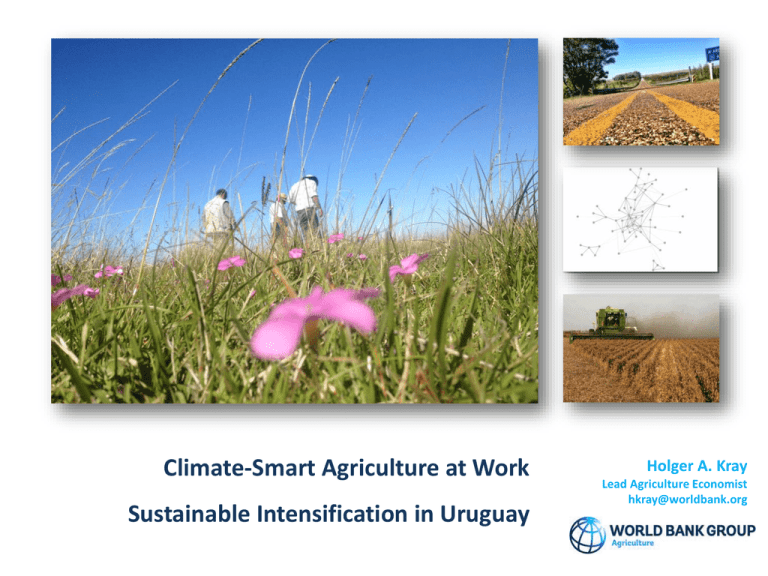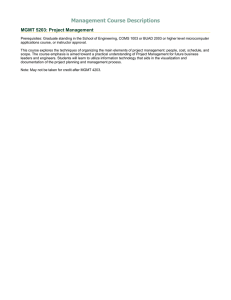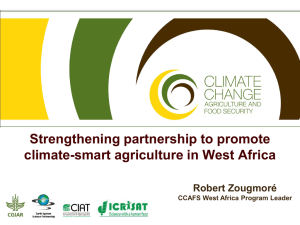Climate-Smart Agriculture at Work Sustainable Intensification in Uruguay Holger A. Kray
advertisement

Climate-Smart Agriculture at Work Sustainable Intensification in Uruguay Holger A. Kray Lead Agriculture Economist hkray@worldbank.org Global Challenges 1 PRODUCTIVITY Feeding 9 Billion People in 2050 Food Production by Region 1972-2050 (Constant 2004-06 US$) 4,000 3,500 3,000 2,500 Asia 2,000 1,500 Latin America 1,000 Africa Oceania 500 Europe North America 0 1972 1982 1992 2002 2012 2030 2050 CEA 2013 based on FAO 2012 Food Demand By Commodities in 2050 relative to 2005-07 (Billion kg per year) 2 ADAPTATION Climate Change Impacts on Food Systems Problems Today: Short Term Volatility Recent price spikes for food commodities have been linked to extreme weather events CCAFS 2014; World Bank 2008 Issues Tomorrow: Medium Term Yield Losses and Increasing Cost Structures Maize and wheat yields show climate impacts Uncertain Future: Production Collapse in the Longer Term Maize and wheat yields show climate impacts EMISSIONS Agriculture a main contributor 3 LAND USE CHANGE ~11% OF TOTAL FOREST LAND 63% Land Use Change 11% Buildings 6.4% CROPLAND 25% IPCC 2014 Agriculture 13% LIVESTOCK 62% Electricity & Heat Production 25% Transport 14% BURNING BIOMASS 11% AGRICULTURE ~13% OF TOTAL TOTAL EMISSIONS FERTILIZATION 16% RICE - 10% Industry 21% Other Energy 9.6% OTHER - 12% Climate-Smart Agriculture (CSA) Delivering Solutions by Focusing on Three Outcomes INCREASED PRODUCTIVITY ENHANCED RESILIENCE LOWER EMISSIONS 6 Local Challenges The Case of Uruguay Uruguay: Intensification at a Stunning Pace generates simultaneous opportunities and challenges feeds 28m people 30 increased fourfold in 10 years 20 10 0 2001 2005 2009 2013 Number of People Fed By Uruguay’s Agro-Food Exports [million people at world average calorie intake] Source: MGAP OPYPA based on FAO & Trademap Challenge 1: UY’s Economy Depends on Agriculture Agricultural resilience is a key determinant of overall economic resilience Challenge 2: Agricultural Growth Puts Pressure on Natural Resources Production intensifies as consequence of increasing product and land prices Development of UY Land Markets Challenge 3: UY is Increasingly Vulnerable to Climate Change The country faces an unprecedented number of adverse weather events Precipitation Record [2000-2012] Source: R Source: RENARE, 2013 Storm Damage to (New) Grain Storage Facility [Dolores, 2013] Source: R Source: Bank team, 2013 Local Solutions The Case of Uruguay Widening Acceptance of Resource-Adapted Production Techniques Focus on Quality & Conservation Agriculture Public Goods & Internalization of External Environmental Costs Soil-Use Planning Example of Soil Quality Mapping Source: R Source: RENARE, 2014 Area covered by Farmer-Submitted Soil Use Plans [2014] Source: RENARE, 2014 Source: R Information and Decision Support Technologies & #BigData in Agriculture Refining the Agricultural Information System • Identification of vulnerabilities and opportunities – • Understand, quantify and reduce uncertainties – • Source: R Source: FAO, 2013 • Understand the Past; Monitor the Present; Provide information for the Future Identify technologies that reduce vulnerability – Actual Land Use relative to Sustainable Carrying Capacity [%] Which (sub)sectors, systems, components? Diversification; irrigation, storage and efficiency enhancement in water use; genetics; etc. Identify institutional rules and interventions through policies that reduce/transfer risks – – – Early Warning and Early Response Systems Insurance (incl. Index-based); financing mechanism Institutional framework and policies Example: Better decision making in Climate-adapted Policy and Enterprise Decisions Family farmers Climate Modeling from leading research universities Water Monitoring Grasslands Monitoring Risk Mapping Early Warning on drought, production Livestock registration system (SNIG) Example: Better decision making in Water Resource Protection •Identification of water sources with potential problems •Elaboration of monitoring indicators •Faciliatation of inspection of enterprises •Support to the identification of mitigation options Example: Better decision making in Resources Protection and Traceability Global Solutions The Approach of the World Bank 1 2 3 CLIENT COUNTRY ENGAGEMENT Advising clients and designing projects to increase productivity, build resilience and reduce emissions. MAINSTREAMING Applying a ‘Climate Lens’ to our work across sectors, both from adaptation and emission reduction perspectives. METRICS & TARGETS Of the current World Bank agriculture portfolio: 75% of projects improve productivity. 31% build resilience. 20% reduce emissions. 12% are fully climate-smart, working towards all three goals: $850 Million in the fiscal year 2011/2012 Opportunities to Deliver Climate-Smart Agriculture Solutions P R E P R E NORTH AMERICA & EUROPE Biodigesters Fertilizer Mgmt (also: new types) Supply Chain Mgmt LATIN AMERICA Livestock Efficiency Agroforestry Rice (AWD+) Pasture Mgmt Fertilizer Mgmt Zero Till R P E P R E AFRICA Agroforestry Pasture Management Fertilizer Application P - Productivity R - Resilience E - Emissions ASIA Rice (AWD+) Livestock Efficiency Biodigesters Fertilizer Mgmt Degraded Land Restoration




